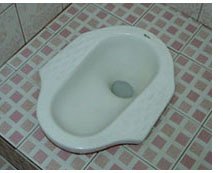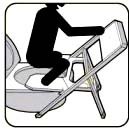|
Squatting Facets – Little Bones That Make A Big DifferenceVery few Western adults are able to squat easily and comfortably because they do not have well-developed squatting facets, which are special bone structures found in the feet and ankles of those who are able to do so. It is not because Westerners are different from other races, for all babies are born with squatting facets. (One habit of toddlers is that they would instinctively squat -- feet flat on the floor, in absolute comfort -- to answer the call of nature.) In cultures where squatting is part and parcel of life -- when planting and growing, picking up things, cleaning, cooking, washing, childbirth, emptying the bowels -- squatting facets are well formed. But in societies where people mostly sit and stand, and rarely squat, facets are no longer evident or are poorly developed. Without squatting facets, a person would find it difficult to squat easily and comfortably. In an Australian study, the researchers were surprised to discover that one out of three volunteers were unable to hold the squatting position for more than 30 seconds, before falling backwards. It means that up to one third of the Australian population are not able to squat properly. Recent scientific studies have revealed the reason for the lack of squatting facets in Westerners. How Squatting Facets Are Retained In 2005, a team of scientists analyzed 100,000 year old bones belonging to Middle Stone Age human-like creatures that have been discovered in a South African cave. SIDENOTE One of the scientists studying the bones was Dr Jeffrey Schwartz, a professor of anthropology and history at the University of Pittsburgh. In a Dec 15, 2005 Discovery News article entitled Stone Age Humans Often Squatted, Dr Schwartz talked about their findings and conclusions: "We examined bones that belonged to the big toe, second toe, and pinky (little) toe of two to three individuals who lived in South Africa 100,000 years ago." "Three toe bones… reveal that humans 100,000 years ago frequently squatted…" "Our discovery suggests that Middle Stone Age humans, along with a possible human ape ancestor, already were engaged in some kind of agricultural work at this relatively early phase in human history." Dr Schwartz explained how the research team had arrived at the conclusion that early humans frequently adopted a squatting posture and engaged in agricultural activities: "When someone squats, various joints are 'squeezed' together in an extreme that brings bone surfaces into contact with each other that otherwise would not, such as the bones that link the lower legs to the feet and toes." "If this activity (squatting) is done for long periods of time with some regularity, the (bone) surfaces that make contact become remodeled into what are called squatting facets, which are huge on…metatarsals (foot bones)." "Squatting is often associated with agricultural activities, such as planting, weeding, etc." What Can Make Squatting Facets Disappear... What the bone study team had failed to see was the connection between their research findings and a strange characteristic of Westerners:
It doesn't require much to recognise the root cause. In Western societies, children and adults are compelled to sit on potties and sitting toilets. It appears that sitting is more dignified and civilized than squatting, the favourite stance of people in the other parts of the world... The result? Inevitable and gradual loss of squatting facets. In the words of the bone study team: "If this toilet activity (sitting, sitting toilets) is done for long periods of time with some regularity, the (bone) surfaces do not make contact, leading to the loss of squatting facets on...the metatarsals (foot bones)." Is it any wonder why Western adults fare so poorly when it comes to squatting? Yet there is hope for those who desire to change all this. With determination and regular practice, squatting facets can develop and come back again…and with it, the ability to squat. Close Squatting Facets Page
|
The Best Toilet Converter in The World Today!


Helping People All Over
The World Achieve
Good Health Through
Correct Toileting Posture
Watch video on the
origin and story of
the Sandun-Evaco
toilet converter
All about Life,
Hope and Truth...
FREE:
One of the most
astounding books
you will ever read
in your life!




 (Two thirds of humanity – in Asia, Africa and the Middle East – still use traditional squatting toilets to perform their bodily functions.)
(Two thirds of humanity – in Asia, Africa and the Middle East – still use traditional squatting toilets to perform their bodily functions.)



